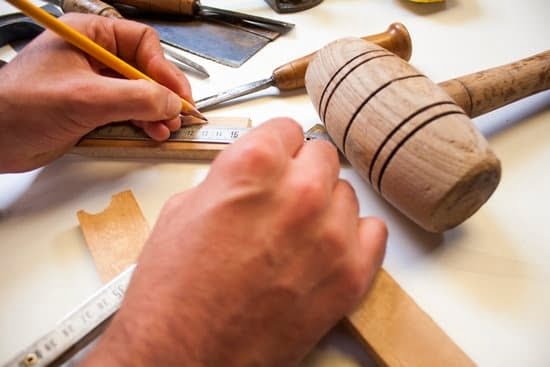What is woodworking joinery? Woodworking joinery refers to the art and technique of joining together two pieces of wood to create a strong and sturdy connection. This age-old practice has been used for centuries in furniture making, carpentry, and woodcraft, playing a crucial role in the construction and design of various wooden structures.
Woodworking joinery is not only a functional aspect of woodworking, but it is also considered an art form that showcases the craftsmanship and skill of the woodworker. From simple butt joints to intricate dovetail and mortise-and-tenon joints, the variety and complexity of joinery techniques make woodworking an endlessly fascinating craft.
In this article, we will explore the history and origins of woodworking joinery, delve into the different types of techniques used, discuss its importance in furniture making, examine the tools and equipment required for successful joinery work, highlight common mistakes to avoid, provide tips and tricks for perfecting woodworking joinery, and showcase stunning examples of woodworking joinery projects.
Whether you are a novice woodworker or an experienced craftsman, understanding the fundamentals of woodworking joinery is essential for creating beautiful and durable wooden pieces.
The History and Origins of Woodworking Joinery
Woodworking joinery has a rich history that dates back centuries, with evidence of intricate joinery techniques found in ancient civilizations such as Egypt, China, and Greece. The art of woodworking joinery has been an essential part of the construction of furniture, buildings, and other wooden structures throughout history.
Origins in Ancient Civilizations
In ancient Egypt, complex woodworking joinery techniques were used to construct furniture and sarcophagi. The use of dovetail joints and mortise and tenon joints is evident in the remains of Egyptian wooden artifacts.
In China, traditional woodworking joinery techniques such as the “dovetail through” joint have been used for thousands of years to create elaborate wooden structures without the use of nails or screws. These early examples demonstrate the importance of woodworking joinery in ancient cultures and its lasting impact on craftsmanship.
Evolution Over Time
As civilizations advanced, so did the techniques and methods used in woodworking joinery. The Middle Ages saw the development of new joint types such as the tongue and groove joint as well as advancements in tools that allowed for more precise and intricate joinery work. The Industrial Revolution brought about changes in how woodworking was done, with the introduction of power tools and machinery that revolutionized woodworking joinery techniques.
Influence on Modern Woodworking
The history and origins of woodworking joinery have had a significant influence on modern practices. Many traditional joinery techniques are still used today, alongside newer methods made possible by technological advancements. Understanding the history behind these techniques not only provides valuable insight into their significance but also inspires woodworkers to continue honing their craft in this age-old tradition.
Different Types of Woodworking Joinery Techniques
Woodworking joinery is the process of joining together pieces of wood to create a strong and seamless connection. There are various techniques used in woodworking joinery, each with its own unique characteristics and applications. Below are some of the different types of woodworking joinery techniques:
1. Butt Joint: This is one of the simplest and most basic woodworking joinery techniques. It involves joining two pieces of wood by simply butting them together and using adhesive or fasteners to hold them in place.
2. Dovetail Joint: Dovetail joints are known for their strength and durability. This technique involves creating interlocking teeth on the edges of the wood pieces, which fit together like a puzzle. Dovetail joints are commonly used in furniture making, particularly in drawers.
3. Mortise and Tenon Joint: This classic woodworking joint consists of a protruding tenon on one piece that fits into a corresponding hole (mortise) on another piece. It is widely used in traditional timber framing as well as in cabinetry and furniture making.
4. Finger Joint: Also known as box joint, this technique involves cutting interlocking rectangular cuts into the ends of two pieces of wood, which then fit together like fingers interlaced.
Each type of woodworking joinery technique has its own strengths and weaknesses, making them suitable for different applications depending on the specific needs of a project.
Learning about the different types of woodworking joinery techniques can help woodworkers select the most appropriate method for their projects, ensuring strong and durable connections between wood pieces. By understanding these techniques, woodworkers can elevate their craftsmanship and produce high-quality woodworking projects that stand the test of time.
Importance of Woodworking Joinery in Furniture Making
Woodworking joinery is a crucial aspect of furniture making, as it determines the strength, durability, and overall aesthetic appeal of the final piece. Joinery techniques play a significant role in ensuring that furniture is not only visually appealing but also functional and long-lasting. Moreover, the type of joinery used can also affect the style and design of the furniture, making it an essential component in the creation of various furniture pieces.
One of the main reasons why woodworking joinery is important in furniture making is because it provides structural support to the different parts of a piece. Strong and well-executed joinery ensures that the furniture can bear weight and withstand everyday use without falling apart. Additionally, quality joinery can enhance the longevity of furniture, reducing the likelihood of repairs or replacements in the future.
Furthermore, woodworking joinery greatly influences the overall design and style of furniture. Different types of joinery techniques can create unique visual elements, adding character and charm to each piece. For example, dovetail joints are not only strong but also add a touch of elegance to a piece of furniture. The importance of joinery in furniture making cannot be overstated, as it directly impacts both form and function.
| Importance Factors | Details |
|---|---|
| Structural Support | Ensures strength and durability |
| Design Influence | Adds visual appeal and uniqueness |
| Longevity | Reduces need for repairs or replacements |
Tools and Equipment Used in Woodworking Joinery
Woodworking joinery requires a variety of tools and equipment to create strong and beautiful wood connections. One of the most essential tools is the chisel, which is used for shaping and carving out wood to create precise joints. There are different types of chisels that can be used for specific woodworking joinery techniques such as dovetail, mortise and tenon, and rabbet joints.
Another important tool is the saw, which comes in various types including handsaws, backsaws, and Japanese pull saws. Each type of saw is suitable for different woodworking joinery tasks such as cutting precise angles or creating straight cuts for joining pieces of wood together. Additionally, a coping saw or fret saw may be used for more intricate cuts and shaping.
Clamps are also indispensable in woodworking joinery to hold pieces of wood together while the adhesive dries. They come in various sizes and styles such as bar clamps, pipe clamps, and spring clamps to accommodate different project needs. In addition to clamps, other essential equipment includes marking tools like a marking gauge or knife, as well as measuring tools such as a combination square or marking template.
Finally, power tools like routers and jigsaws can also be used in woodworking joinery to speed up the process and create more complex joints. These power tools allow for greater precision and efficiency when working on larger or more detailed projects.
| Tools | Equipment |
|---|---|
| Chisels | Saws – handsaws, backsaws |
| Clamps | Marking tools – marking gauge |
| Routers | Jigsaws |
Common Mistakes to Avoid in Woodworking Joinery
Woodworking joinery is the craft of connecting different pieces of wood together to create a strong and seamless joint. It is an essential skill for anyone involved in woodworking, whether it be for creating furniture, cabinets, or even artwork. In this section, we will explore some common mistakes to avoid in woodworking joinery to ensure the quality and durability of your projects.
One of the most common mistakes in woodworking joinery is not properly measuring and marking the wood pieces before making the cuts. This can result in ill-fitting joints that are either too loose or too tight, compromising the overall strength and stability of the finished piece. To avoid this mistake, it is important to take accurate measurements and use a marking tool to clearly indicate where the cuts should be made.
Another frequent error in woodworking joinery is using the wrong type of joint for a particular project. Different types of joints are suited for specific applications, and using the wrong one can lead to structural weaknesses in the final product. It is crucial to understand the purpose and function of each type of joint and select the appropriate one based on the design and requirements of your project.
Furthermore, neglecting to properly prepare and align the wood pieces before joining them together can result in misaligned joints and gaps between the surfaces. This can diminish the visual appeal and integrity of the finished piece. Taking the time to carefully prepare and align the wood pieces before assembling them is imperative for achieving precise and professional-looking joints.
To ensure successful woodworking joinery, it is crucial to avoid these common mistakes by practicing good measurement techniques, selecting appropriate joint types, and taking care when preparing and aligning wood pieces for assembly. By doing so, you can enhance both the aesthetic quality and structural integrity of your woodworking projects.
Tips and Tricks for Perfecting Woodworking Joinery
Woodworking joinery is a fundamental aspect of woodworking that requires precision, skill, and patience. While it may seem daunting at first, there are several tips and tricks that can help you perfect your woodworking joinery techniques.
Choose the Right Wood
One of the most important aspects of perfecting woodworking joinery is choosing the right type of wood for your project. Different woods have different densities, grains, and workability which can greatly affect the outcome of your joinery. It’s essential to understand the characteristics of various types of wood and select one that is best suited for your specific joinery needs.
Take Your Time and Be Patient
Rushing through woodworking joinery projects often leads to mistakes and inaccuracies. It’s crucial to take your time and be patient with each step of the process. Whether you’re cutting, measuring, or assembling joints, precision is key. By taking your time and being meticulous with each detail, you’ll be able to achieve perfectly fitting joints that add strength and beauty to your woodworking projects.
Practice Makes Perfect
As with any skill, practice is essential for perfecting woodworking joinery. Start by mastering basic joint techniques such as butt joints, lap joints, and mortise-and-tenon joints before moving on to more complex joinery methods. By dedicating time to regular practice, you’ll gradually improve your skills and confidence in creating flawless woodworking joints.
By implementing these tips and tricks into your woodworking practice, you’ll be well on your way to mastering the art of woodworking joinery. With patience, dedication, and continuous learning, you can achieve seamless, sturdy joints that will elevate the craftsmanship of your woodworking projects.
Examples of Stunning Woodworking Joinery Projects
Woodworking joinery is the craft of connecting wooden pieces together to create a structurally sound and visually appealing finished product. There are various techniques and methods used in woodworking joinery, each with its own unique characteristics and applications. One of the most fascinating aspects of woodworking joinery is the stunning projects that can be created using these techniques.
One example of a stunning woodworking joinery project is the traditional Japanese “dovetail” joint, known as “kachi-tsugi” or “suji-biki.” This type of joinery involves intricately interlocking wooden pieces without the use of any nails or screws. The result is a seamless and beautiful connection that showcases the skill and precision of the craftsman.
Another impressive woodworking joinery project is the “mortise and tenon” joint, commonly used in furniture making. This method involves creating a socket (mortise) in one piece of wood that perfectly fits a protrusion (tenon) on another piece. When executed with accuracy, this joint creates a strong, durable, and visually appealing connection between two wooden pieces.
Furthermore, there are also stunning examples of woodworking joinery projects that incorporate more modern techniques such as finger joints, box joints, and rabbets. These projects often showcase a blend of traditional craftsmanship and contemporary design, resulting in eye-catching pieces that highlight the versatility and creativity of woodworking joinery.
Whether it’s creating intricate patterns with interlocking wooden pieces or seamlessly joining multiple components to form a larger structure, these stunning woodworking joinery projects demonstrate the artistry and skill required to master this craft.
Conclusion
In conclusion, woodworking joinery is a timeless and essential craft in the world of furniture making and woodworking. It is the art of connecting two pieces of wood together through various techniques and methods, creating strong and durable joints that are both functional and aesthetically pleasing. From its ancient origins to its modern-day applications, woodworking joinery has been a staple in the creation of furniture, cabinetry, and other wooden structures.
The history and origins of woodworking joinery date back centuries, with traditional techniques being passed down through generations. Different cultures have developed their own unique styles of joinery, showcasing the versatility and creativity that can be achieved through this craft. Today, modern advancements in tools and technology have expanded the possibilities for intricate and precise joinery work, allowing woodworkers to push the boundaries of creativity while still upholding traditional craftsmanship.
Overall, understanding the different types of woodworking joinery techniques, utilizing the right tools and equipment, avoiding common mistakes, and learning tips and tricks for perfecting joinery are all crucial aspects of mastering this craft. With dedication and practice, anyone can create stunning woodworking joinery projects that showcase not only technical skill but also a deep appreciation for the artistry behind joining wood together.
Frequently Asked Questions
What Is Joinery in Woodworking?
Joinery in woodworking refers to the craft of connecting different pieces of wood together using various techniques such as dovetail, mortise and tenon, or box joints. Joinery is essential for creating strong and durable wooden structures and furniture.
What Is the Difference Between Woodworking and Joinery?
The main difference between woodworking and joinery lies in their focus. Woodworking encompasses the entire process of working with wood, including cutting, shaping, and assembling. Joinery, on the other hand, specifically deals with creating connections or joints between wooden pieces.
What Is the Meaning of Wood Work Joint?
In woodworking, a woodwork joint refers to the point where two pieces of wood are joined together. There are various types of woodwork joints, each serving a specific purpose based on the requirements of the project.
Common examples include butt joints, miter joints, and lap joints. These joints play a crucial role in determining the strength and stability of a wooden structure or piece of furniture.

Hi everyone! I’m a woodworker and blogger, and this is my woodworking blog. In my blog, I share tips and tricks for woodworkers of all skill levels, as well as project ideas that you can try yourself.





